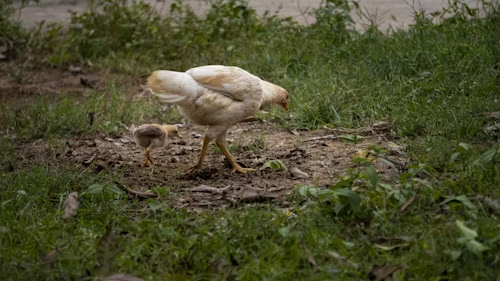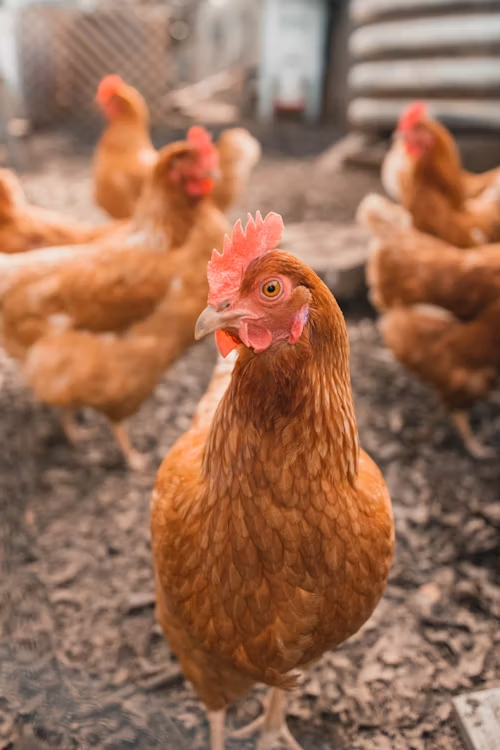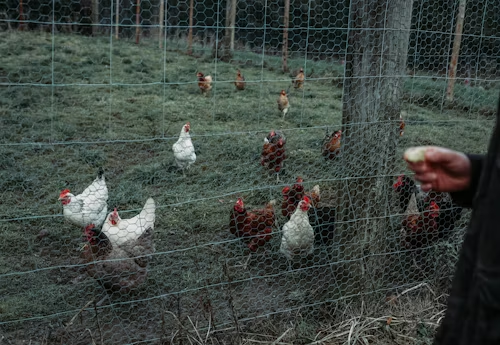Decode your flock's behavior patterns to better understand their communication, social structure, and overall well-being.
Chickens may not be able to talk, but they certainly communicate in their own way. Understanding these behaviors is key to being a successful chicken keeper and can help you identify when your birds are happy, stressed, or even ill. In this guide, we'll explore common chicken behaviors and what they mean for your backyard flock.
The Pecking Order: Understanding Chicken Social Structure
The term "pecking order" comes directly from chicken behavior and describes the social hierarchy within a flock. This natural system determines who gets first access to food, water, nesting boxes, and roosts.
How the Pecking Order Works
In every flock, there is a hierarchy with top-ranking birds (usually hens, or a rooster if present) having priority access to resources:
- The top hen (or "alpha") will eat first and choose the best roosting spot
- Middle-ranking hens have their place but defer to higher-ranking birds
- Lower-ranking hens often wait until others have eaten before approaching feeders
Chickens establish and maintain this hierarchy through various behaviors:
- Pecking: Literally pecking or threatening to peck subordinate birds
- Posturing: Standing tall with neck extended to appear larger
- Chasing: Pursuing lower-ranking birds away from resources
Chicken Keeper Tip:
When introducing new birds to an established flock, do so gradually. Use a method like the "see but don't touch" approach by keeping new birds in an adjacent but separate space for 1-2 weeks before full integration.

Vocalizations: The Chicken Language
Chickens have a rich vocabulary of sounds, each with specific meanings:
The Egg Song
That loud, repetitive cackling after laying an egg isn't just celebration—it's an evolutionary behavior believed to draw predators away from the freshly laid egg. Some hens are more vocal than others.
Contentment Sounds
Soft clucking and trilling indicates contentment, especially when foraging. These gentle sounds help keep the flock together and communicate that all is well.
Warning Calls
A sharp, loud repeated sound alerts the flock to danger. Different calls may indicate aerial predators versus ground threats. Hens will often freeze or seek cover when hearing these calls.
Food Calls
A distinct, excited clucking that indicates a bird has found something delicious. Mother hens use similar calls to alert chicks to food sources.
Broody Sounds
Broody hens make a distinctive low growling sound when disturbed on the nest, warning others to stay away from their eggs.
Rooster Crowing
Beyond the famous morning crow, roosters crow to assert territory and communicate with the flock. They also have specific alarm calls that differ from hens'.
Body Language and Postures
Chickens communicate a wealth of information through their posture and movements:
Happy and Relaxed Behaviors
- Dust bathing: Chickens dig shallow depressions in dry soil, then flap and wiggle to coat their feathers with dust. This natural behavior helps control parasites and keeps feathers in good condition.
- Sunbathing: When you see chickens sprawled out in the sun with one wing extended, they're not ill—they're sunbathing! This behavior helps produce vitamin D and may also help control parasites.
- Preening: Using their beaks to clean and realign feathers indicates a relaxed, content bird.
- Wing stretching and flapping: Regular stretching helps maintain muscle tone and shows the bird is comfortable.

Stressed or Fearful Behaviors
- Feather fluffing with hunched posture: Often indicates illness or extreme cold.
- Hiding or corner huddling: May indicate fear, bullying from other birds, or illness.
- Panting: With wings slightly away from body, indicates heat stress.
- Excessive scratching or pecking at self: Could indicate external parasites.
- Reduced activity: A chicken that separates from the flock or becomes inactive may be ill or injured.
Health Alert:
A chicken that is hunched, fluffed up, and inactive should be immediately separated and examined for illness. These behaviors often indicate a sick bird that needs attention.
Reproductive Behaviors
Nesting and Egg-Laying
Hens often display specific behaviors around egg-laying:
- Increased vocalization and "nest shopping" where they enter and exit various nesting boxes
- Sitting in the nest for extended periods before and after laying
- Arranging nesting material with their beaks and bodies
- The "egg song" after laying (that famous cackle)
Broodiness
When a hen goes "broody," her hormones trigger the desire to hatch eggs:
- She'll occupy a nest continuously, leaving only briefly for food, water, and elimination
- Broody hens flatten their feathers and spread wings slightly to better cover eggs
- They emit a distinctive growl and may peck when approached
- Their comb and wattles often become paler
- They pluck feathers from their breast to create a "brood patch" with increased blood flow and warmth
Some breeds, like Silkies and Orpingtons, are more prone to broodiness than others. Modern egg-laying breeds often have had this instinct bred out of them.
Mating Behaviors
In flocks with roosters, you'll observe specific mating rituals:
- Rooster dancing: A male will perform a dance where he drops one wing to the ground and "dances" in a circle around a hen
- Food tidbiting: Roosters make specific sounds and movements to call hens to food they've found—an evolutionary behavior to demonstrate provider qualities
- Mounting: The actual mating process where the rooster mounts the hen's back, using his beak to hold her neck feathers for balance
Hens typically crouch and extend their wings slightly to indicate receptiveness to mating. Interestingly, a hen may still assume this submissive posture when approached by humans or even other hens in rooster-free flocks—this is normal behavior based on their social hierarchy.
Foraging and Feeding Behaviors
Chickens are natural foragers with specific techniques:
- Scratching: Using both feet in a backward motion to expose insects and seeds in soil or debris
- Ground pecking: Precisely targeting small food items with their beaks
- Running with food: When a chicken finds something particularly valuable, it may run with it to avoid sharing with flockmates
These behaviors are deeply ingrained, and chickens will perform them even when provided with complete feed. Allowing natural foraging enriches their lives and supplements their diet with natural nutrients.

Abnormal Behaviors to Watch For
Feather Pecking and Cannibalism
These problematic behaviors can develop in flocks and require intervention:
- Causes: Overcrowding, excessive light, nutritional deficiencies (especially protein), boredom, or learned behavior
- Prevention: Proper space (minimum 4 sq ft per bird in coop, 10 sq ft in run), balanced nutrition, environmental enrichment, and managing light exposure
- Solutions: Anti-pecking sprays, separating aggressive birds, providing distractions like hanging cabbage or treat dispensers
Egg Eating
Once learned, this habit can spread through the flock:
- Causes: Usually starts with accidentally broken eggs, calcium deficiency, or curiosity
- Prevention: Frequent egg collection, properly designed nest boxes, adequate calcium in diet
- Solutions: Collect eggs multiple times daily, use roll-away nest boxes, place ceramic or wooden eggs in nests to discourage pecking
Seasonal Behavior Changes
Your chickens' behavior will change with the seasons:
Molting
Most chickens undergo annual feather replacement, typically in fall:
- Egg production typically decreases or stops during molt
- Birds may become less active and more withdrawn
- They may look ragged as new feathers grow in
- Protein needs increase significantly during this period
Winter Behavior
- Reduced activity during cold weather to conserve energy
- More time spent in the coop
- Increased food consumption to maintain body temperature
- Possible decrease in egg production due to shorter daylight hours
Summer Behavior
- Heat-reduction behaviors like wing spreading, panting, and seeking shade
- Increased water consumption
- More dust bathing to control increased parasite activity
- Possible decrease in egg production during extreme heat
Using Behavior to Assess Flock Health
Learning to "read" your chickens helps you catch health issues early:
Healthy Chicken Behaviors
- Active foraging and scratching
- Regular dust bathing and preening
- Alert posture with head up and eyes bright
- Normal social interactions within the flock
- Regular eating and drinking
Concerning Behaviors
- Hunched posture with ruffled feathers
- Isolation from the flock
- Reduced activity or lethargy
- Unusual stance or gait
- Decreased food/water consumption
- Labored breathing or excessive panting
Enrichment for Natural Behaviors
Encouraging natural behaviors leads to healthier, happier chickens:
- Foraging opportunities: Scatter treats in straw or leaves to encourage scratching and hunting
- Perches at various heights: Allow for natural roosting behavior
- Dust bathing areas: Provide dry soil mixed with food-grade diatomaceous earth
- Hanging vegetables: Cabbage, lettuce, or cucumber hung at pecking height provides both food and activity
- Mirrors: Small mirrors (with protective framing) can provide social stimulation
- Boredom busters: Commercial chicken swings, xylophone toys, or homemade treat dispensers
When chickens can express their natural behaviors, they experience less stress and are less likely to develop problematic behaviors like feather pecking.
Conclusion: Becoming a Chicken Behavior Expert
Understanding chicken behavior takes time and observation, but the rewards are substantial. The more you learn to "speak chicken," the better equipped you'll be to provide proper care, catch health issues early, and fully enjoy the fascinating social dynamics of your flock.
Keep a journal of your observations, noting seasonal changes, individual personalities, and any unusual behaviors. Over time, you'll develop an intuitive understanding of what's normal for your specific flock and be able to address issues before they become serious problems.
Remember that while chickens share common behaviors, each bird has its own personality. Some are bold explorers, others are shy followers, and some are natural leaders. Recognizing and appreciating these differences makes chicken keeping even more rewarding.



Comments (3)
Sandra M.
July 7, 2023I've been keeping chickens for years but never understood why my Orpington always makes that growling sound when I collect eggs. Now I know she's being broody! This article explained so much about the behaviors I see every day.
Thomas K.
July 8, 2023I was worried when I saw my chickens flopped over with their wings spread out in the sun. Thought they were sick! Turns out they're just sunbathing. Such a relief to know this is normal!
Emily Parker
July 8, 2023Thomas, that sunbathing behavior definitely alarms many new chicken keepers! It's actually a good sign that your chickens feel safe and comfortable in their environment. Keep an eye on them during very hot days though, as they can overheat if they don't have access to shade.
Leave a Comment